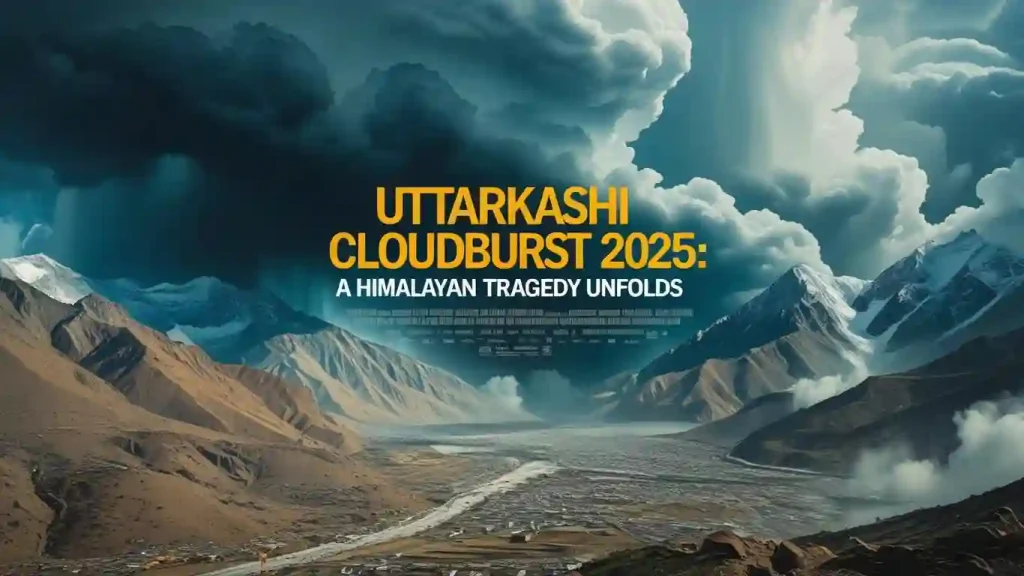
On August 5, 2025, the serene hills of Uttarkashi, a spiritual hub in Uttarakhand, turned into a scene of devastation. A catastrophic cloudburst struck Dharali and Sukki Top, triggering flash floods in the Kheer Ganga river. Homes, hotels, and livelihoods were swept away in minutes, leaving at least five dead, over 50 missing, and a community grappling with loss. As rescue teams battle treacherous conditions, this tragedy underscores the growing threat of climate change in the fragile Himalayan ecosystem. This article explores the disaster’s impact, ongoing relief efforts, and what it means for Uttarkashi’s future.
The Disaster Unraveled: What Happened in Uttarkashi?
August 5, 2025, 1:45 PM—what began as a quiet day in Dharali and Sukki Top turned catastrophic as a fierce cloudburst slammed the area near Gangotri. In moments, the tranquil Kheer Ganga river, a tributary of the Bhagirathi, turned ferocious, surging with floodwaters that swept through the region in a devastating flash. According to reports from The Times of India and Hindustan Times, the floods washed away 20-25 hotels, homestays, shops, and homes, leaving behind a trail of destruction.
The human toll is heartbreaking. At least five lives have been lost, and over 50 people, including 11 soldiers and 28 tourists (many from Maharashtra and Kerala), remain missing. The Gangotri National Highway, a critical route for pilgrims and locals, was severely damaged, with sections completely washed away. Social media platforms like X have been flooded with videos showing raging waters swallowing buildings, with one local quoted as saying, “Our market, our homes—everything was gone in minutes.”
The Indian Meteorological Department (IMD) had issued an orange alert for heavy rainfall in Uttarakhand, but the intensity of this cloudburst caught residents off guard. The disaster has disrupted life in Uttarkashi, a key stop on the Char Dham Yatra, and raised urgent questions about disaster preparedness in the region.
Also Read: How Climate Change Effects Farming: Surviving Floods, Tsunamis, and Thunderstorms for Future Food Security
Heroes in Action: Rescue and Relief Efforts
In the wake of the tragedy, a massive rescue operation is underway. Rescue operations are in full swing, with teams from the NDRF, SDRF, Indian Army, ITBP, and BRO braving harsh conditions to search for survivors and remove debris. Over 150 lives have been successfully moved to safety amidst the chaos. However, relentless rains and obstructed routes continue to challenge and slow down the ongoing efforts.
Leading the charge in rescue efforts, the Indian Army’s 14th Rajputana Rifles—commanded by Colonel Harshvardhan—has been pivotal in reaching and rescuing those stranded by the calamity. Demonstrating swift leadership, CM Pushkar Singh Dhami canceled his Andhra Pradesh trip to lead the emergency response efforts on the ground. Touring the flood-hit areas, he assured swift support, declaring at a press conference in Dehradun, “Every affected family will receive all necessary help—we stand with them in this hour of need.”
The central government has also stepped in, with Prime Minister Narendra Modi and Home Minister Amit Shah assuring full support. Emergency helplines (01374-222126, 01374-22722, 9456556431) have been activated for those seeking assistance or information about loved ones.
For readers looking to help, consider donating to verified relief organizations like the Chief Minister’s Relief Fund or trusted NGOs working in Uttarakhand. Sharing accurate information and avoiding unverified social media posts can also prevent misinformation during this crisis.
Also Read: Climate Change Can Humans Evolve to Survive?
Climate Change and Himalayan Vulnerability
The Uttarkashi cloudburst is not an isolated incident but part of a troubling trend in the Himalayas. Experts attribute the increasing frequency of cloudbursts to climate change, which causes warmer air to hold more moisture, leading to intense, localized rainfall. A 2023 study by the Indian Institute of Science noted that the Himalayan region is warming at a rate 0.2°C higher than the global average, making extreme weather events like cloudbursts more common.
Unplanned construction and deforestation have exacerbated the problem. In Dharali, blocked natural drainage systems amplified the flood’s impact, turning streams into destructive torrents. Environmentalist Anil Joshi, quoted in The Indian Express, warned, “The Himalayas are fragile. Without sustainable development, such tragedies will only increase.”
The Uttarkashi disaster highlights the need for better urban planning, early warning systems, and reforestation efforts. As climate change intensifies, policymakers and communities must prioritize resilience to protect vulnerable regions like Uttarakhand.
Impact on Pilgrims and the Local Economy
Uttarkashi is a vital hub for the Char Dham Yatra, attracting thousands of pilgrims annually to Gangotri, one of the four sacred shrines. The cloudburst has disrupted this spiritual journey, with the Gang otri highway’s closure stranding tourists and pilgrims. The loss of hotels and homestays in Dharali has dealt a severe blow to the local economy, which relies heavily on tourism.
For locals like shopkeepers and homestay owners, the disaster is a personal tragedy. “My hotel was my family’s lifeline. It’s all vanished now,” a Dharali local posted on X. The economic ripple effects could linger for months, especially as the monsoon season continues to deter visitors.
The broader tourism industry in Uttarakhand faces challenges too. With schools closed and rivers like the Ganga flowing above danger levels, the state’s appeal as a safe destination is under scrutiny. However, the resilience of Uttarkashi’s people shines through, with communities banding together to support each other.
What Can Be Done? A Path Forward
The cloudburst in Uttarkashi serves as a stark reminder that urgent action can no longer wait. Here are steps individuals and policymakers can take:
- Support Relief Efforts: Donate to verified organizations or volunteer with local NGOs to aid recovery.
- Raise Awareness: Share credible information about the disaster and climate change’s role in it.
- Advocate for Sustainability: Advocate for sustainable tourism, large-scale reforestation, and the development of infrastructure built to withstand natural disasters.
- Travel Smart: If visiting Uttarakhand during the monsoon, check weather alerts and avoid high-risk areas.
For travelers, the IMD’s website (www.imd.gov.in) provides real-time weather updates, and emergency helplines are available for assistance. Staying informed can save lives.
Conclusion: Rebuilding with Resilience
While the Uttarkashi cloudburst 2025 caused immense damage, it also revealed the resilience and togetherness that define the people of this region. As rescue teams work around the clock and communities begin to rebuild, the tragedy underscores the urgent need to address climate change and protect the Himalayas. By supporting relief efforts and advocating for sustainable practices, we can help Uttarkashi recover and prevent future disasters.
FAQs
How many people died in the Uttarakhand flood in 2025?
In the 2025 Uttarakhand flood triggered by a cloudburst in Uttarkashi’s Dharali village, at least 5 people died, and over 60 remain missing, including 11 army personnel. Rescue operations are ongoing amid landslides, damaged roads, and harsh weather conditions.
Who is the biggest flood in India?
The 2013 Uttarakhand flash flood is considered the biggest in India, killing over 5,000 people and devastating Kedarnath and surrounding areas.
What is the cloud burst in the Himalayas?
A cloudburst in the Himalayas is a sudden, intense rainfall event—over 100 mm in under an hour—often triggering flash floods, landslides, and destruction in high-altitude regions like Uttarkashi.
How many people lost their life in Kedarnath flood?
In the 2013 Kedarnath flood, over 6,000 people lost their lives, making it one of India’s deadliest natural disasters.
Why does cloudburst happen in hilly areas?
Cloudbursts happen in hilly areas due to rapid upward movement of warm, moist air that cools and condenses quickly over steep terrain, triggering intense rainfall. The mountains force air to rise faster (orographic lift), making these regions more prone to sudden, localized downpours.
